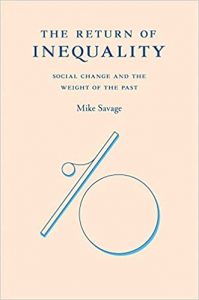Book Review: The Return of Inequality: Social Change and the Weight of the Past by Mike Savage
The Return of Inequality: Social Change and the Weight of the Past. Mike Savage. Harvard University Press. 2021.
Find this book (affiliate link):
Mike Savage’s new book is long and weighty, as befits its subject: the return of inequality as an issue to be understood in all its contemporary grotesque complexities. Savage is probably best known for his work on class and social stratification, including the BBC collaboration The Great British Class Survey and the Pelican book Social Class in the 21st Century, as well as for his work on the sociology of culture and the history of social methods. His new book starts from the premise that inequality is now once again a major topic of public and academic concern. Unlike the start of this century, it argues, when public discourse was saturated with ideas that we were, by and large, advancing into a progressive future via social liberalism, technological globalisation and knowledge-based economic growth, today the stark, unavoidable realities of economic and social inequalities, democratic breakdown and climate crisis have set a new tenor, a new normal. No longer can social science take refuge in the comforting delusion that we exist in an era of reflexive modernisation at the end of history.
The introduction discusses how inequality has surfaced as a cause for concern over the past decade. There has been a ‘turning of the telescope’: an increasing sense that the rich, rather than the poor, might need to be the subject of scrutiny, and indeed might be the main social problem, as evinced by both the Occupy movement and the rise of ‘elite studies’ in sociology. Today, it argues, inequality now even bothers the wealthy much more: elites cannot use wealth to guarantee their own security in a world they can ‘no longer predict and control’. It points to the mainstream success of books on inequality, and in particular Thomas Piketty’s Capital in the Twenty-First Century (with which it is fascinated). The book discusses the problems of the social sciences: its siloed nature, rigid disciplinary boundaries, the fetishisation of big data devoid of social and historical context. Inequality ‘has come to prominence precisely as the anomaly that troubles conventional social science models’.
The Return of Inequality therefore sets out to provide an ambitious interdisciplinary re-theorisation of inequality and, in particular, to bring a historical understanding to the table. It argues that the accumulated ‘weight of the past’ has surfaced in a myriad of contexts, from Black Lives Matter to right-wing nationalism to #MeToo. Savage’s undergraduate degree was in history, and the book is at pains to emphasise both that sociology is ‘not fundamentally different from history or geography’ in its scope and that the imbrication of the humanities and social sciences is crucial and necessary. Appropriately, each chapter takes as its point of departure a particular graph, image or table – from the Gini coefficient, to Pierre Bourdieu’s spatial map of distinction, to a photograph of Rhodes Must Fall – and uses it to launch its exploration into a different facet of inequality. There is an ongoing engagement with the power of the visual.
The Return of Inequality is split into three parts. The first considers established theories of inequality; the second analyses its various different dimensions; the third weighs up what is to be done. Part One is where Savage is by far on surest ground. Its three chapters pivot around the work of Piketty, Bourdieu and Karl Marx respectively, but range well beyond. They feel like instant seminar room classics, providing magnificently lucid analytical overviews of the different historical techniques and traditions used to measure economic inequality, cultural and social capital and wealth accumulation.
The latter section places wealth rather than just income inequality fully into the picture of today’s rentier-driven, asset-based economy. Savage writes of how, in most ‘developed’ nations, ‘50% of wealth is now inherited’. Because we are now returning to a world with higher capital stocks, ‘the weight of the past is returning, and along with this comes resurgent elitism, patronage, discrimination, and the entrenchment of inherited privilege’.
Part Two of the book is the longest and is more experimental than the first. Its six chapters range across different dimensions of inequality (imperialism and the nation state; the body, ‘race’, class and gender; cities and space; changing dynamics of data and knowledge). The key argument is that inequality trends are associated with elite formation amongst competing global powers, which it traces back through the formation of nation states as well as to past and present imperial projects.
Along the way, this section argues against identity politics, and instead for an approach examining how ‘visceral inequalities’ of the body become more profound as relative social inequalities decline yet historical inequalities remain unaddressed. It is critical of the post-war liberal vision of social mobility, of its expectations of evaporating inequality ‘in the hot sun of affluence driven by economic growth’. It analyses the changing inequalities of cities, arguing that they are now less modernistic and dynamic than receptacles for sedimented capital. And it discusses how the widespread practice of ‘de-reading’ and rise of shorter digital attention spans has been harnessed by elite corporate wealth.
Part Three suggests what should be done. Policy alone can’t cut it, Savage argues, at a time when politics is returning to the parameters of the nineteenth century: characterised not so much by left and right divisions as by ‘intra-elite axes, often organised around religious or geographical divides’. In such a context – within the fraying fabric of nation states and resurgent nationalism – appeals to ‘effective skilled management’ are themselves part of the political problem. Instead Savage gives us a five-point plan: reviving radicalism; de-centring economic growth; holding capital to account; redistributing wealth; and cultivating ‘sustainable nationalism’.
The Return of Inequality is a hugely generative book. Its deeply contextual approach, theoretical breadth and historical consciousness make a major contribution to understanding inequality today. It is excellent to think with. Inevitably there are issues in need of much further discussion. For instance, gender is well considered as part of the ‘visceral inequalities’ section, but overall plays a relatively minor role. The book would benefit from including the work of more female sociologists who have written about this topic (like Sylvia Walby’s Globalization and Inequalities) and more on global gendered inequalities. Similarly, environmental crisis and sustainability are rightly emphasised at the beginning and end of the book, but this could do with much greater development and emphasis throughout.
I also have some issues with the prescriptions of the final chapter (whilst finding them good overall). The book advocates ‘sustainable nationalism’ whilst dismissing both nationalisation (on the ground that it’s authoritarian) and cosmopolitanism. This is problematic, both because cosmopolitanism has a more multifaceted history than Savage acknowledges, and because any consideration of a sustainable nation state surely needs to be accompanied by overt commitments to cosmopolitanism and transnationalism, to avoid all the obviously exclusionary dangers the nation state brings. Plus, explicitly throwing out any form of nationalisation as political strategy is an ideological relic from the very era of neoliberal third way politics that Savage is critiquing (at a time when the NHS urgently needs recommitting to nationalisation, and when collectivising ownership of broadband and energy would address many problems the book identifies). More engagement with pre-existing suggested solutions, both academic (such as Andrew Sayer’s book Why We Can’t Afford the Rich) and from the work of think tanks and NGOs, would also be useful at the end of the book.
Such quibbling is in part the product of different perspectives, positions, generations; our entry points into the issue of inequalities are not the same. For instance, I was part of a generation of social theorists participating in the European Social Forums in the 2000s where inequality was already very much on the agenda (despite the best efforts of much social theory). We all have different geographical and generational perspectives because of where and how we were thrown into the conjuncture. What makes this book so good is how it situates the inequalities of the present by rigorously extending existing theories, by imaginatively joining so many historical dots together and by capaciously expanding this difficult and necessary conversation. At the same time, there is clearly plenty of work still to do.
- This review first appeared at LSE Review of Books.
Please read our comments policy before commenting.
Note: This article gives the views of the author, and not the position of USAPP – American Politics and Policy, nor of the London School of Economics.
Shortened URL for this post: https://bit.ly/3qPbCtk
About the reviewer
Jo Littler – City, University of London
Jo Littler is Professor of Social Analysis and Cultural Politics in the Department of Sociology at City, University of London.
 Find this book (affiliate link):
Find this book (affiliate link):
No comments:
Post a Comment